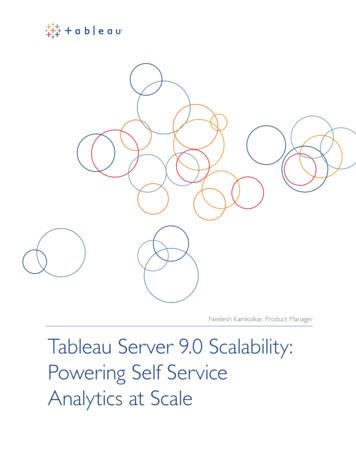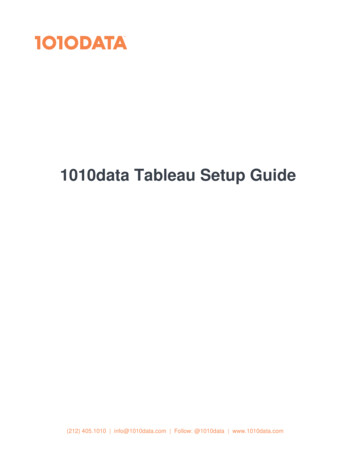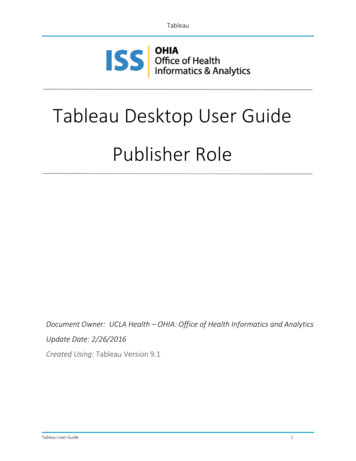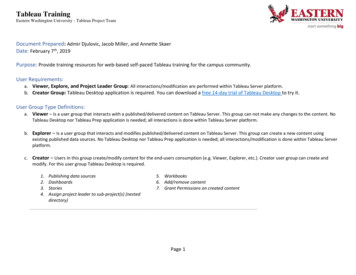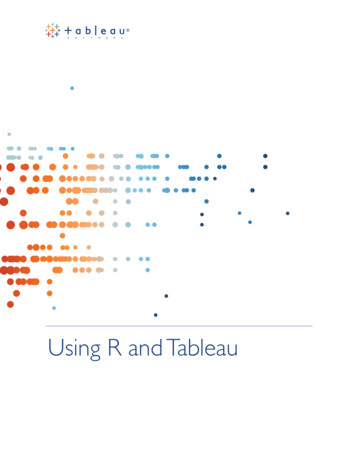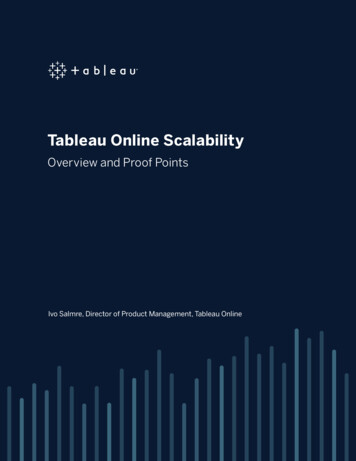
Transcription
Tableau Online ScalabilityOverview and Proof PointsIvo Salmre, Director of Product Management, Tableau Online
ContentsIntroduction. 3Tableau Online worldwide architecture. 3Multi-pod, multi-geography architecture . 3Site migrations . 4Architecure inside a pod . 5Security. 6Backups. 6Resource governance. 6Supporting 24/7 mission-critical sites . 7Service Level Agreement (SLA). 7Data Management and Resource Blocks . 8Proof points: Worldwide customer usage. 8Case study: Tableau’s alpo-dev site on Tableau Online. 9How does alpo-dev resemble typical customer enterprise sites?. 10How is alpo-dev different from typical customer Online usage?. 10Site configuration. 10Authentication, user, and group provisioning. 10Configuring and provisioning Tableau Bridge. 11Monitoring and troubleshooting the alpo-dev site.12Alpo-dev site statistics.12Appendix — Q&A.13About Tableau & additional resources. 15Tableau Online Scalability2
IntroductionPart of our mission to help people see and understand data means ensuring our customers have confidencein the scalability and availability of our SaaS analytics platform, Tableau Online. When everyone in yourcompany depends on data and analytics, you can’t afford to let them down. And we believe it’s importantyou understand how our hosted service leverages enterprise-grade cloud technology to scale as fluidly asyour business grows.This document describes Tableau Online’s high-level architecture and explains how the architecture scalesto serve large sites with thousands of geographically distributed users. You will learn how one of Tableau’slargest internal sites is configured and performs at scale in Tableau Online.Tableau Online worldwide architectureMulti-pod, multi-geography architectureTableau Online has a pod-based architecture hosted on Amazon Web Services (AWS) that supportsgeographically distant pods. To simplify sign-in, these pods are unified by a common front door system atonline.tableau.com. All infrastructure is geographically redundant. Tableau Online has multiple customerpods located across the globe in the United States, Western Europe, Japan, and Australia. The Japan andAustralia pods were launched in 2020 to better serve customers in these geographic regions.As is common for pod-based cloud services, each customer’s site is homed on a specific geo-located pod.When signing in, a customer is routed to the pod where their site is hosted. Figure 1 below illustrates thearchitecture.The customer and user management system, backed by a Customer Pod Routing Database, maps sitesTableau Online Scalability3
and users to pods. This system also facilitates single organizational identity management by routing tothe customer’s single sign-on (SSO) systems (SAML/SCIM/OpenID), such as Okta, Microsoft Azure ActiveDirectory, Ping Identity, or OneLogin.Tableau Online Front Door Systemhttps://online.tableau.comCustomers Pod Routing DatabaseHighly available geographicallydistributed redundancyUS West RegionUS East RegionJapan RegionAustralia RegionWestern Europe RegionFigure 1 Multi-pod, multi-geography architectureCustomers choose their initial geographic pod when creating their site. Tableau can expand the set of podsboth within each region as customer growth dictates as well as expand the infrastructure within each podto service expanded usage.Site migrationsCustomers occasionally choose to migrate to a new site within the same region or move to a differentgeographic region. This usually occurs when two organizations have merged, when an organization splits,or when organizations choose to move to a new region based on where their users or data reside.Tableau offers a self-service process to migrate content (workbooks, data sources, flows) between sitesusing the Tableau Content Migration Tool. The Content Migration Tool can also be used to move contentbetween on-premises Tableau Servers and Tableau Online; an important capability for customers movingtheir infrastructure into the cloud. The tools and self-service process are available to customers for theduration of their migration between sites or between Tableau Server and Tableau Online.Tableau Online Scalability4
Architecture inside a podEach pod is designed to host thousands of customer sites and their users’ interactive sessions within a multitenant (shared compute) environment. Pods are hosted in AWS, using Amazon Elastic Cloud Computing (EC2) forscalable compute and Amazon Relational Database Service (RDS) for highly available database. Figure 2 showsthe pod architecture.Customer Bridge ClientsInbound Customer RequestsCustomer Bridge ClientsTableau Online Front Door ITYZONE 1BackgroundWorkersSites/Content Repository(RDS)Sites/Content Repository(RDS)Network File StorageNetwork File StorageAVAILABILITYZONE 2Figure 2 Architecture inside a podEach pod is fronted by an Elastic Load Balancer which distributes traffic to available workers. Where possible,traffic is stateless and sequential requests are routed to available machines. Some traffic (e.g. interactivevisualization sessions) is inherently stateful; a visualization session may start on any application worker(chosen by the load balancer) but the interactive visualization is then “sticky” to the machine and process towhich it was assigned.Dual availability zones are supported within each pod to ensure redundant availability.Durable customer state (e.g. workbooks, data sources, user information, data extracts, bridge configuration) isprimarily managed by a storage system that consists of the site and content repository Amazon RDS database aswell as cloud hosted network file storage. These systems are backed up and replicated in redundant availabilityzones. The system is designed for high availability and elastic capacity upgrades; for example, system storagecan be quickly expanded with pod growth.Tableau Online Scalability5
Three kinds of worker machines are managed as pools of Amazon EC2 compute resources. All are designedfor easy expansion with pod growth. Application Workers service requests initiated by end users via browsers, administrative APIs, desktopclients and mobile clients. B ackground Workers service scheduled tasks. The pool of background worker machines pullsscheduled work from the Site/Content Repository (Amazon RDS). Background work includes extractrefreshes, alerting, and email subscriptions. Bridge Connectors manage connections initiated by Tableau Bridge clients and route live-queryrequests to the customer-hosted bridge clients.These worker machines are kept up to date with the most recently released versions of Tableau’s software.Tableau Online hosts many 24/7 mission-critical sites where availability is of utmost importance and can’tafford business discontinuity during system upgrades. Most system upgrades and required patches areperformed with no downtime, thereby causing no disruptions to the customer’s business.SecurityTableau has achieved SOC 2 compliance for the Tableau Online service. Tableau services are hosted in datacenters that are SOC 2 Type II audited. Copies of these reports are available under NDA. More informationand a copy of the Tableau Online SOC 3 report are available on our website.Automated and manual vulnerability testing is done as a part of the development process and third-partysecurity firms are leveraged to conduct penetration testing of applications before major releases. Quarterlyaudits are performed for critical elements of the Tableau environment. Learn more about Tableau OnlineSecurity in the Cloud.BackupsPods are backed up for disaster recovery purposes. Tableau Online backs up its stateful data for each poddaily. For redundancy, the backups are replicated across multiple Amazon Availability Zones in their AWSRegion. Backup retention is 30 days. Tableau Online periodically tests system recovery from backups.Resource governanceWe are always looking to improve our ability to grow, scale, and manage Tableau Online predictably andefficiently. To provide customers with a stable and reliable experience, Tableau Online has built-in resourcegovernance that limits outlier usage patterns in one customer’s site from negatively impacting othercustomers. Learn more about Tableau Online site capacity.Tableau Online Scalability6
Supporting 24/7 mission-critical sitesTableau Online is built for high availability. Tableau takes advantage of both the high availability featuresavailable in the product as well as cloud architecture best practices to deliver a reliable experience onTableau Online. There are many automated monitoring processes as well as engineers on call 24/7 in theevent a condition is detected that requires human intervention.Tableau actively monitors system capacity (e.g. machine processor utilization, background utilization,queue time for background tasks, file input/output, network bandwidth utilization) and has processesin place to add additional worker machines and additional file/network throughput as needed to handlepeaks in traffic. Tableau can also isolate demanding workloads and route them to specialist workermachines within a pod. Because all Tableau Online infrastructure is on virtualized cloud infrastructure,we have high resource elasticity that can be used to grow the pods and route traffic to meet demand.Tableau actively keeps track of the load inside each of our pods and has a healthy engineering factorof-safety that plans for additional pods before approaching the capacity limits of existing pods. Tableauregularly expands capacity by creating new pods in existing and new regions.Service Level Agreement (SLA)Tableau is committed to running Tableau Online with a monthly availability percentage of 99.9% foreach regional pod. This percentage is based on the success and error rate of key functions and means ourcustomers will be able to access and explore their site with better than 99.9% availability each month. Wemeasure success by tracking our customer’s ability to do things like sign in, access the home page, andsuccessfully navigate and access their projects.Customers enrolled in Tableau Online Premium Support are eligible for credits in the event of TableauOnline not achieving better than 99.9% monthly availability percentage for a given month. Additionaldetails for this are available in the Service Level Objective and Service Level Agreement (SLA) sections ofthe Tableau Online Support Policy and Tableau Online Premium Support Policy respectively—read themon our website.Tableau Online Scalability7
Data Management and Resource BlocksWith the Data Management Add-on, Tableau Online enables customers to run scheduled Tableau Prepflows to combine data from a variety of sources, transform it, clean it, and output high quality publisheddata sources. Because data transformation jobs can be long-running and resource-intensive processes,and often need to run at definite times to serve customers’ daily needs, Tableau Online offers the capacityto customers through purchased Resource Blocks. By default, the Data Management Add-On for Onlinecomes with one Resource Block, allowing Prep Flows to be run sequentially throughout the day. Customersneeding more concurrency can purchase additional Resource Blocks. Through Resource Blocks, TableauOnline supports both common data transformation needs and can scale up to demanding customer needsthat require many concurrent data transformation jobs running 24/7.Proof points: Worldwide customer usageSince launching in 2013, Tableau Online now serves over 19,000 customer sites with 450,000 seats.(customers range from 1-10 seats to over 12,000 seats). From data gathered for the period between Januaryand March 2020, Tableau Online’s worldwide pods serve the following customer needs. 19,000 customer sites 14,000,000 views/month 1,400,000 email subscriptions/alerts monthly 700,000 workbooks (over 1,600 customer sites have more than 100 workbooks each) 2,000,000 data connections 280,000 extract refreshes dailyTableau Online Scalability8
Case study: Tableau’s alpo-dev site on Tableau OnlineTableau has two major deployments to service its own business and operational analytics needs. One isa company-wide Tableau Sever deployment known as “alpo,” and the other is a departmental TableauOnline site that supports the core business activities of the Development team known as “alpo-dev.”Alpo-dev runs on a Tableau Online pod and is supported by the same team and engineering operationsprocesses as customer pods. Workbooks on this site are business-critical to Tableau’s development team.The vizzes on automated test results, status of the continuous development pipeline, defects, and TableauOnline usage are required to carry out engineering activities on a day-to-day basis.Members of Tableau’s development team are encouraged to actively use alpo-dev, and many peoplepublish content daily, ranging from critical product metrics to data reporting the availability of free foodleft over from meetings in Tableau’s Seattle headquarters. These vizzes are powered by a variety of datasources, including on-premises, Tableau-managed on AWS, and in the public cloud. As such, Tableau’sown use of Tableau Online serves as an excellent case study for rich enterprise cloud customer usage.Figure 3 below illustrates the data topology.Tableau OnlineCentral BridgeClientsData lic CloudSQL ServerXLS and CSV FilesPostgreSQLMySQLON-PREMISES(Tableau managed)Figure 3 Data connectivity on alpo-devTableau Online Scalability9
How does alpo-dev resemble typical customer enterprise sites? Enterprise identity — Identity management and authentication are managed with an enterpriseidentity provider (IdP). On-premises and cloud data — There is a hybrid data architecture with a mix of servers includingon-premises, Tableau-managed in AWS, and public cloud. There are many different data sources,including SQL Server, PostgreSQL, MySQL, Redshift, Snowflake, Google Big Query, and flat files. A poolof Tableau Bridge services facilitates the live on-premises or VPC database query capabilities, as well asscheduled extract refreshes. Worldwide usage — Users are located around the world, and view Tableau Online through the web,desktop, and mobile clients inside the corporate network, through the VPN, and over the public internet.How is alpo-dev different from typical customer Online usage? Advanced deployment — Tableau runs pre-release software on alpo-dev’s pod. We do this to ensurechanges to Tableau Online’s software and infrastructure work at scale before we deploy to customers. Heavy usage patterns — Our users are extremely active! One of Tableau’s company values is “Weuse our products,” and alpo-dev reflects this value. As you might expect, Tableau’s own internal usagepatterns represent above-average usage. All users are Tableau Creators — Any user can create and publish a workbook or data source.This means the alpo-dev site has lots of workbooks and lots of extracts (both centrally managed andpersonal). Heavier workload — Because of our very active user base of creators, the alpo-dev workload is heavierthan the workload of a typical enterprise site with a similar number of provisioned users.Site configurationAlpo-dev runs in the US West Coast region. The US West Coast region was chosen because the largestnumber of Tableau’s engineers and many data sources reside in this region, although the site does haveregular users from the US east coast and Europe.Authentication, user, and group provisioningLike many companies moving to the cloud, Tableau has adopted a cloud-based Identity Provider (IdP)—in our case Okta—that provides single sign-on (SSO) capabilities to the many applications deployed atTableau as an enterprise standard. Users can also be provisioned using the IdP, and the IdP also managessecurity requirements such as two-factor authentication (2FA).Tableau Online Scalability10
The alpo-dev site is configured to use Okta as its SAML provider for authentication, so users can use theirregular corporate credentials to authenticate to the site. This IdP is configured to require 2FA to connectto Tableau Online outside of Tableau’s network and VPN. SCIM is also enabled on alpo-dev, so Okta canprovision and de-provision users through Tableau’s own internally managed IT groups.Configuring and provisioning Tableau BridgeTableau relies on many on-premises data sources and data sources within VPCs, including SQL Server,PostgreSQL, and AWS Redshift data sources. Tableau Bridge is an important part of the alpo-devdeployment. Published data sources connect live to on-premises data and extracts taken by Tableau Bridge.For increased reliability and load balancing, alpo-dev administrators maintain a central pool of TableauBridge clients for live connections and extract jobs. Here are some details about the configuration: A fter monitoring extract times and failure rates using the provided administrative views, administratorschose to run eight bridge clients. A ll bridge clients run in a single pool, and there is no differentiation between clients for live and extractjobs. F or IT administration and reliability, Tableau Bridge runs in service mode, so the client runs in thebackground and is automatically restarted at reboot. There is a shared AD account that owns the clients. N o special firewall configuration is required. Bridge clients sign in to Tableau Online and authenticatewith the supplied credentials in the same way as any other web application.End users can also use their own Tableau Bridge clients in the alpo-dev environment to manage extracts.Users contact the site administrator if they would like for their extract to be managed centrally. Additionaldetails on managing and running Tableau Bridge are available in our Help documentation.Tableau Online Scalability11
Monitoring and troubleshooting the alpo-dev siteAlpo-dev has a designated site administrator. Administering the alpo-dev site is a part-time set of dutiesbecause the overall system monitoring is handled by Tableau Online.There is monitoring software installed on the machines hosting the bridge clients, which monitorsvarious metrics including uptime, connectivity, hardware utilization, etc.; no other software is required.Tableau Bridge analytics can also be seen in the site’s administrative reports page. The Tableau Bridgesettings page includes status information on each bridge client, which can help troubleshoot issues. Theadministrative views included in the Status page provide insights needed to investigate other site issuesreported by users. No specialized software is used to troubleshoot routine analytics issues.Alpo-dev site statisticsAlpo-dev has a very engaged user base. In a seven-day range, nearly 900 of over 1400 provisioned userswere active on alpo-dev. On a single day basis, we may see 500-600 active users.Like most sites, alpo-dev has peaks and valleys of traffic. Most workdays see over 3000 views a day. Arecent meeting resulted in a spike of traffic of over 7000 views in a single day on alpo-dev without anydegradation in site performance.Figure 4 View count on alpo-devLike many companies, there are a few hours of the day where there is a burst in traffic. During these peakhours, we typically serve over 500 views in an hour, though on a recent burst date we saw 1,264 viewsserved in the peak hour.As we saw in Figure 3, Tableau uses a wide variety of data sources. About 25% of data source accesses werethrough Tableau Bridge. Tableau sees anywhere from 1700 to 2500 bridge extract refreshes per day. Thisrepresents hundreds of GB in data throughput through bridge clients.Tableau Online Scalability12
Appendix – Q&AHere we’ve compiled some common questions from enterprise customersand our answers.Q: This whitepaper explains that Tableau Online now uses elastic file storage. How are my extractspartitioned and indexed? Is there physical separation?A: The extracts are stored in elastic storage, and each extract is itself indexed uniquely in that storage(somewhat similar to how Amazon S3 offers a large bucket where discrete pieces of informationare stored with unique keys). These indexes themselves are logically partitioned per customer. In acloud hosted service, tenants are logically separated (it is very rare to physically separate the data forcustomers). Given this, the operative questions are “How good is the logical partition of the data?” and“At what layers is this partitioning enforced?” The top-level partition is in the database where customer data is logically partitioned by customertenant ID (essentially a very big number unique to each customer). This partition ID is used to “stripe”all the other resources we manage per customer and enforce in our application. It’s important tounderstand that in no case whatsoever can customers directly access our databases or underlyingstorage systems; all customer access is only though application logic, which enforces customer-tenantpartitioning at multiple levels. All this said, if you require “physical separation,” then cloud hosting is probably not right for you—inthese cases Tableau Server is the right choice (e.g. to support HIPAA, PII data, etc.). In almost all cases,when people talk about cloud systems, the partitions are by definition logical partitions.Q: M y organization wants to be able to use our own external tools to analyze site administrative andauditing information. Can I have access to access log data from Tableau Online?A: We love the scenario, but access to log file data is not the solution. Tableau Online will absolutely notshare logs, as that would be a bad security practice—this is not the intended purpose of logs, whichis for system diagnostics—but the auditing need makes sense. Tableau Online supports Online AdminInsights, the ability to build custom workbooks that audit the sites’ activity. If there is a need to exportthis data (e.g. as a CSV for further analysis), you can use tools such as TabCmd.Tableau Online Scalability13
Q: C an I set my own backup policy on my Tableau Online site?A: If you wish to create or download a local copy of your content, you can do so through the TableauOnline APIs. .Q: D oes Tableau work with third parties to validate and test Tableau Online security?A: Yes. In addition to an in-house security team, Tableau works with multiple third-party cybersecurity experts to perform penetration testing and other security related auditing.Experience the reliability and scalabilityof Tableau Online — get started today!Tableau Online Scalability14
About TableauTableau is a complete, integrated, and enterprise-ready visual analytics platform that helps people andorganizations become more data driven. Whether on-premises or in the cloud, on Windows or Linux,Tableau leverages your existing technology investments and scales with you as your data environmentshifts and grows. Unleash the power of your most valuable assets: your data and your people.Additional ResourcesTableau Online Security in the CloudTableau Online: Keeping Your Data FreshHelp documentation for Tableau Bridge
Tableau Online Front Door System Customers Pod Routing Database tts/onine.taea.co i avaiae eoraia distrited redndany US West Region US ast Region apan Region Australia Region Western u rope Region Figure 1 Multi-pod, multi-geography architecture Customers choose their initial geographic pod when creating their site. Tableau can expand the set of pods both within each region as customer growth .


